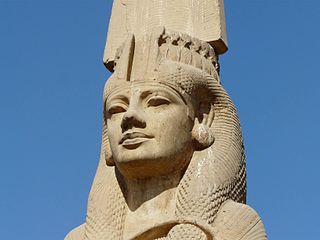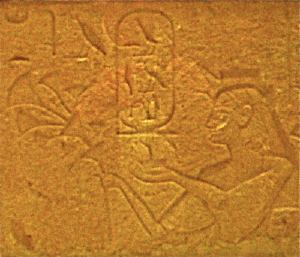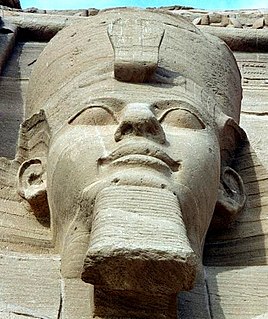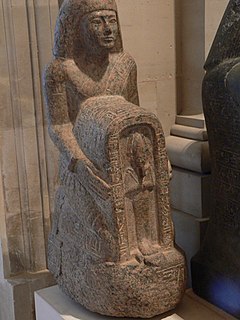| Yuny Viceroy of Kush | |
|---|---|
 Yuny kneeling before Seti I (stela at el-Kanaïs) | |
| Predecessor | Amenemopet |
| Successor | Heqanakht |
| Dynasty | 19th Dynasty |
| Pharaoh | Seti I, Ramesses II |
Yuni served as Head of the-stable-of-Seti-I, Charioteer of His Majesty, and Chief of the Medjay before becoming Viceroy during the reign of Seti I. [1] He would use some of these titles simultaneously. On a stela from Abydos -now in the Cairo Museum (Jd'E 34620) - the inscription reads:
In the New Kingdom of Egypt, the Medjay were an elite paramilitary police force, serving as desert scouts and protectors of areas of Pharaonic interest.
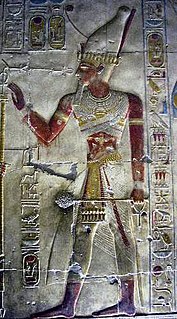
Menmaatre Seti I was a pharaoh of the New Kingdom Nineteenth Dynasty of Egypt, the son of Ramesses I and Sitre, and the father of Ramesses II. As with all dates in Ancient Egypt, the actual dates of his reign are unclear, and various historians claim different dates, with 1294 BC to 1279 BC and 1290 BC to 1279 BC being the most commonly used by scholars today.
Contents
Made by the Superintendent of Deserts in the Southern Foreign country, Viceroy in Nubia (Ta-Sety), Chief of Works in the Estate of Amun, Chief of the Madjayu-militia, Iuny.(Kitchen) [2]
The former Kingdom of Kerma in Nubia, was a province of Ancient Egypt from the 16th century BCE to eleventh century BCE. During this period, the polity was ruled by a viceroy who reported directly to the Egyptian Pharaoh. It is believed that the Egyptian 25th Dynasty were descendants of these viceroys, and so were the dynasties that ruled independent Kush until the fourth century CE.
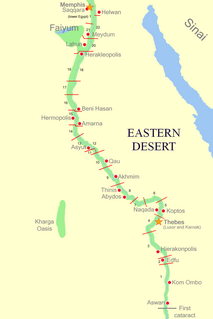
Ta-Seti was the first nome of Upper Egypt, one of 42 nomoi in Ancient Egypt. Ta-Seti also marked the border area towards Nubia.
Yuni started the Egyptian building projects at Amara West and Aksha. [3] It was "on his orders that the first blocks of the Abu Simbel temples were cut. [3] Yuny commemorated his work with a rock-cut scene showing himself standing before Ramesses II on the Abu Simbel cliff. [3] After ten years under Ramesses II, Yuny retired from his post in Nubia. [3] He was succeeded by Heqanakht.

Aksha is an ancient Egyptian temple, rebuilt in part at the National Museum of Sudan in Khartoum. The temple was built around 1250 BC by Ramses II. It is situated in the far north of present-day Sudan, a few kilometers south of Faras, on the west side of the Nile. On the temple walls, several sacrifices are depicted. The location of the temple was not well chosen, as it is only a few inches above the high tide of the Nile. This resulted in penetration of the lower wall layers, salt crystallization on the wall surfaces, and stones being worn down over the centuries. In addition, the temple was preyed upon by the local population. Other finds at the site include cemeteries, parts of Qubanstele, and the stele with the "blessings of Ptah".

Abu Simbel is a village in the Egyptian part of Nubia, about 240 kilometers southwest of Aswan and near the border with Sudan. As of 2012, it has about 2600 inhabitants. It is best known as the site of the Abu Simbel temples.

Nubia is a region along the Nile river encompassing the area between Aswan in southern Egypt and Khartoum in central Sudan. It was the seat of one of the earliest civilizations of ancient Africa, with a history that can be traced from at least 2500 BC onward with the Kerma culture. The latter was conquered by the New Kingdom of Egypt under pharaoh Thutmose I around 1500 BC. Nubia was home to several empires, most prominently the kingdom of Kush, which conquered Egypt during the 8th century BC during the reign of Piye and ruled the country as its Twenty-fifth Dynasty.





